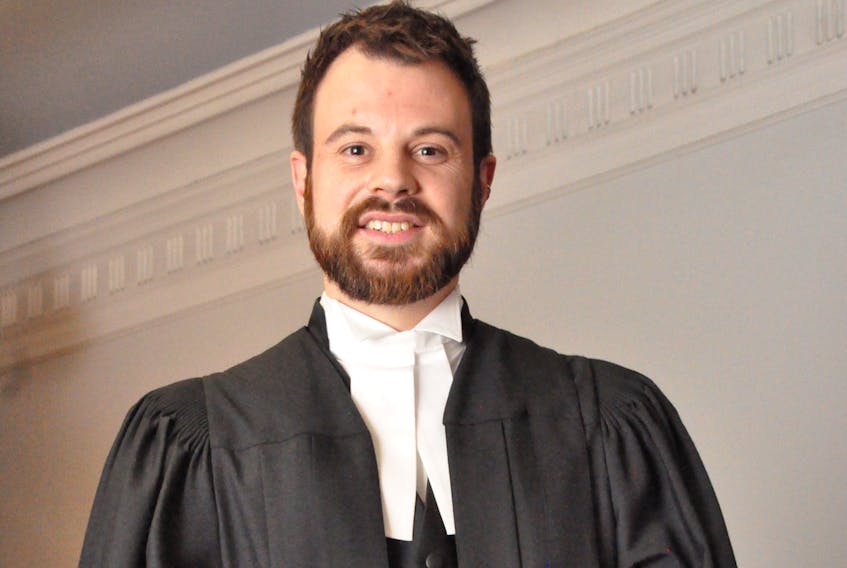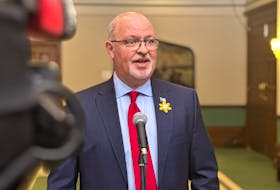Around this time five years ago, Greg Johannson had given up on life.
The Vancouver native, addicted to heroin, found himself homeless on the streets of Halifax, spinning a web of lies to family and friends back home to conceal his addiction.
But it wasn't the stresses brought on by major life changes colliding in the summer of 2013 that led Johannson, now 34, to intravenous (IV) drug use. Addiction was always there.
"I realized when I was 18 or 19 that I couldn't control my use of anything. At first it was alcohol, weed and then I got into other drugs and it was those, too," he says. "So, I realized pretty early that I couldn't control it and I really thought I was going to die young from addiction. Although I knew this was the course of my life, I didn't think there was anything I could do about it."
But Johannson was able to escape the clutches of addiction and reclaim his lust for life. Earlier this month, having graduated from Dalhousie's Schulich School of Law last year, he was one of 20 new lawyers called to the bar by the Law Society of Newfoundland and Labrador, marking the start of his career with the Newfoundland and Labrador Legal Aid Commission in Gander.
Getting clean starts with coming clean — to yourself and others — and that's part of the reason why Johannson is willing to tell his story, so others struggling with addiction can see there is hope for everyone.
The downward spiral
At 25, already abusing alcohol and cocaine, Johannson broke an ankle and was prescribed opiates to combat the pain.
"I don't like that typical narrative about, ‘I got prescribed opiates and I became addicted.' It was just another drug for me, a more enjoyable drug that didn't have as many obvious consequences," he says, noting alcohol's hangovers and cocaine's anxiety and insomnia.
"There wasn't that immediate after-effect, so I kind of fell in love with that."
"I don't like that typical narrative about, ‘I got prescribed opiates and I became addicted.' It was just another drug for me, a more enjoyable drug."
Another benefit to opiates was that Johannson's friends, some of whom had expressed concern over his lifestyle, assumed he had kicked his habits.
"I was able to abuse drugs at home and go out and still be social, but it wasn't as obnoxious of a Greg."
Once alcohol and cocaine slowly left the stage, opiates became the main act and stayed for six years until the summer of 2013 when heroin stole the show.
He doesn't blame his introduction to heroin on a breakup with a girlfriend that summer, but the bachelor life meant no one was looking over his shoulder.
By that point, Johannson, already with a political science degree from Concordia, had settled on attending Dalhousie over the University of Ottawa for law school that September.
With friends and family across the country and no one keeping an eye on him in Halifax, opiates took hold of his life and he became a daily IV user. A month into law school, he stopped attending classes.
"I was able to hide the addiction from everyone. I would make sure not to have video Skype calls … because if people saw me, they'd see how much weight I had lost."
Secrecy became paramount, trumping even the best of intentions.
"I was able to hide the addiction from everyone."
On a trip home to Vancouver at Christmas, Johannson came clean with his parents about an addiction to opiates, but said nothing to them about IV use. He returned to the East Coast with every intention to give up the drugs, but it never happened.
"At that point, I basically gave up. I said, OK, I can't control this anymore. I made no attempt at life anymore and that's when I spent a bit of time homeless.
"The secrecy was so overwhelming, that's why I'm so open about it now. No one knew and it was just months of lie after lie to cover up other lies."
In the spring, Johannson found his way back to Vancouver, where — because of his physical appearance: weight loss, track marks — he had no choice but to pull back the curtain for family and friends and begin to deal with his disease head on.
Related stories:
Eastern Health boosting mental health, addictions support on Burin Peninsula
Application deadline for mental health and addictions grant program approaching
Vancouver's Canucks help fight stigma of addiction in new public awareness campaign
Following a visit to Insite, Vancouver's safe injection site, he sat on a milk crate in a nearby alley and called a rehab centre on Vancouver Island. The guy who answered heard the sirens in the background and told Johannson he'd been there, too.
"Being able to speak to this guy who had been exactly where I was, geographically and emotionally, gave me that hope. That's the other main reason why I share my story, to be able to communicate to the world that recovery is possible. If my message can touch someone else that way, it's a success."
Johannson, with one last fix coursing through his veins, walked into the rehab centre in late May 2014.
"The floor opens beneath you and you fall down and spend about five days in the worst type of psychological and physical pain I can imagine being in," he says of the withdrawal.
"I don't want to be dramatic, but it's like you make some type of a descent into hell."
But Johannson resurfaced and walked out of the facility clean two months later. He's remained that way ever since.
The road to recovery
Relapse, he says, hasn't been part of his story because he had reached the point where the fear of living without drugs paled in comparison to the overwhelming negative emotions evoked from living with addiction.
After eight months in a recovery house and the first half of 2014 living with some friends in Victoria while working at a gourmet restaurant, Johannson returned to Halifax and law school.
"Recovery remains a very active part of my life and it's not something I can ever turn my back on."
"I went back and did the right thing and tapped into the recovery network there and became very open with my story. Not all people in recovery are like that, but I found that it's such the opposite of what I was before and the secrecy that was around my life."
He started speaking at hospitals, joined the executive of the law school's Sober Support program, served as a health mentor for students in Dal's faculty of health professions, helping them gain an appreciation of the patient's point of view, and worked in Alcare Place, a recovery house in downtown Halifax.
Along the way, Johannson may have shied away from some of the more festive law school parties and was acclimating to a somewhat forgotten introverted personality, but he made lasting friendships and met his girlfriend, Kristy Cleghorn.
Recovery for an addict is a lifelong process. It may not be an everyday thing, but to be successful it has to remain the top priority.
Johannson says in addition to remaining active in recovery networks, meditation and art projects have become very important parts of his life.
"Recovery remains a very active part of my life and it's not something I can ever turn my back on."
Without question, Johannson's experiences have shaped him as a lawyer and only added to his pre-existing desire to make the world a better place as much as one person can. Above all, it has strengthened his sense of empathy.
"Being able to see the fact that, especially in criminal defence, everyone has a story, and taking the time to learn that story and be able to relate in some way to where people are coming from, if only to know that you don't know what they've been through."
Twitter: kennoliver79
A come from away who came to stay (for a while)
What compels a 30-something man from Vancouver, where all his family and friends still live, the world at his fingertips and no previous connection to Gander, Newfoundland and Labrador, to relocate there?
It wasn't the great snowmobiling or easy access to international flights at the local airport.
About six years ago, Greg Johannson got the idea of living and working in Newfoundland.
While living in Ottawa and trying to get accepted into law school, an always-adventurous Johannson started looking for interesting and different jobs across Canada.
"I applied at some bizarre places, including a fish plant somewhere in Newfoundland, I don't remember where it was. At that time, I thought it would be really cool to live in rural Newfoundland."
He didn't get the job, but the idea stuck, so when the opportunity arose to complete his articles at the provincial Legal Aid Commission office in Gander, he was delighted to apply and be accepted.
"I find a lot of peace in a small town. I think ultimately I am an urban person and I will move back to the city one day, but I'm much more relaxed living in a smaller environment than a city."
Today, he and his girlfriend, Kristy Cleghorn, who is completing her articles with the Legal Aid Commission office in Clarenville, live together in Glovertown.
Related stories:
Eastern Health boosting mental health, addictions support on Burin Peninsula
Application deadline for mental health and addictions grant program approaching
Vancouver's Canucks help fight stigma of addiction in new public awareness campaign









